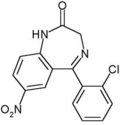Clonazepam
Clonazepam (marketed by Roche under the trade-name Klonopin® in the United States and Rivotril® in Canada and Europe) is a drug which is a benzodiazepine derivative. It is a highly potent and powerful sedative, hypnotic, anticonvulsant, amnestic and anxiolytic. more...
Pharmacology
Like other benzodiazepines, clonazepam is believed to act by simulating the action of GABA on the central nervous system. Because of strong anxiolytic properties and euphoriant side-effects it is said to be among the class of 'highly potent' benzodiazepines with a higher risk of abuse, misuse and dependence than other benzodiazepines. The sedative effects of Clonazepam are relatively weak, compared to its strong anxiolytic and anticonvulsant effects. One quarter of a milligram (0.25mg) of Clonazepam is equivalent to five milligrams (5.00mg) of Diazepam.
Indications
Clonazepam is commonly prescribed for:
- Epilepsy
- Anxiety disorder
- Panic attacks
- Restless leg syndrome (RLS)
- Inital treatment of mania, together with firstline-drugs such as lithium, haloperidol or risperidone
- Hallucinogen persisting perception disorder (off-label use)
- Chronic fatigue syndrome
- Night terrors
Clonazepam is rarely used as a treatment for insomnia, because its sedative effects are relatively weak compared to other benzodiazepines.
Availability
Clonazepam was approved in the United States as a generic medication in 1997 and is now manufactured and marketed by several companies.
Clonazepam is available in the following forms:
- Tablets: 0.25, 0.5, 1.0, and 2mg
- Liquid concentrate: 2.5mg per ml
- Oral wafers: 0.25, 0.5, 1.0 mg
- Injection concentrate: 1mg per ml
Dosage
Epilepsy
Status epilepticus - 1mg is given slowly by I.V.; if seizures persist additional doses of 1mg may be given in intervals of 10 to 20 minutes.
Clonazepam can be useful for long-term treatment of some petit-mal forms of epilepsy in children and adolescents (adults may also respond well).
Up to 30% of epileptic patients treated with clonazepam develop a serious tolerance to the anticonvulsant effects. This may require dose increases or gradual withdrawal and replacement of the drug.
Oral doses in long term treatment of epilepsy vary from 1mg to 20mg, depending upon the severity of case and the weight of the patient. Treatment should be initiated at a low dose, and can be increased gradually if necessary.
Other
- Anxiety and panic disorders - 1mg to 10mg daily, in divided doses
- Restless Leg Syndrome - 1mg to 2mg at bedtime
- Mania - Up to 20mg daily, in divided doses
Side Effects
Because Clonazepam can impair both mental and motor function, those taking it are advised to use caution when operating motor vehicles or machinery, or engaging in hazardous occupations requiring mental alertness. Side effects include:
Read more at Wikipedia.org



